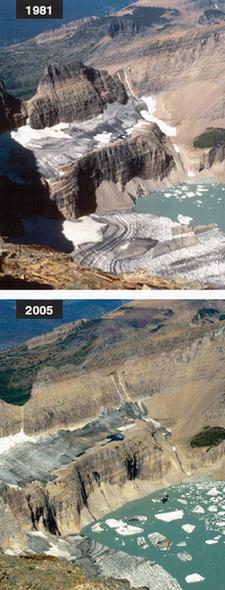本月1日,美國一份全球暖化衝擊國家公園的研究報告出爐,其中明確指明25處美國國家公園、湖岸、海岸、自然或史蹟保護區等景點,是受全球暖化衝擊最嚴重的地區。該報告主要作者、洛磯山脈氣候變遷組織(RMCO)負責人斯蒂芬桑德斯警告:「氣候異常是美國國家公園有史以來遇到最大的威脅。」報告中說,氣候變遷的強烈衝擊包括幾個層面:除了雪、水流失以外,海平面上升將淹沒濱海的國家公園,劇烈的暴風雨也將帶來過多的水量。這些因素都在破壞公園中的棲地,使得動植物消失。
這份《國家公園險境》報告由RMCO與自然資源保護委員會(NRDC)合作提出,在此之前,6月間由眾議院通過的清潔能源法案,才在9月底提到參議院中審議。「國家要確保這些公園的未來,就像過去承諾要保護的一樣。」自然資源保護委員會中的資深成員西奧斯賓塞(Theo Spencer)表示,「清潔能源法案如果能順利通過,不但有助於維繫國家資產,同時還能創造更多就業機會,促進經濟成長及國家安全。」
該報告的32項主要建議中,建議美國國會、行政單位,及美國國家公園局,能擴大現有的國家公園並著手規劃新的預定地,以保存最具美國自然和文化代表性的典範給後世。報告書還提出其他補救措施,例如全面制定清潔能源相關法案,並控制主要溫室氣體二氧化碳的排放,目標是在2020年時,二氧化碳排放量至少減到目前排放量的20%以下。

冰河國家公園境內 Grinnel 冰河退縮情形。
上:Carl Key攝影,USGS提供。下:Blase Reardon攝影,USGS提供
報告中警告,所有國家公園中的冰川都在溶化,包括德納里國家公園與保留區(Denali National Park and Preserve)、雷尼爾國家公園(Mount Rainier National Park)及優勝美地國家公園(Yosemite National Park)等。如果再不處置,這些冰川將在12至13年中完全消失。
在洛磯山國家公園中,溫度上升使山松甲蟲(mountain pine beetle)大量繁殖,因而使大量的樑木松(lodgepole pine)死亡。「看到大量的樹木死亡,遊客都感到驚訝與憤怒。」該公園發言人凱爾‧帕特森說。這些樹皮甲蟲(bark beetle)感染範圍將近5萬英畝,相當於19%的國家公園。
點此閱讀《國家公園險境》報告書。
"Climate disruption is the greatest threat ever to America's national parks," warns Stephen Saunders, president of the Rocky Mountain Climate Organization and principal author of a new report released Thursday that identifies the 25 U.S. national parks, lakeshores, seashores and monuments most at risk of global warming.
Severe impacts of climate change include loss of snow and water, the report states. Another impact of the warming climate is too much water as rising seas flood coastal parks and extreme storms bring torrential rains. Parks also stand to lose plants and animals as their preferred habitats disappear.
The report, "National Parks in Peril," by Rocky Mountain Climate Organization and Natural Resources Defense Council, follows the introduction of clean energy and climate legislation in the U.S. Senate earlier this week. The House of Representatives passed its climate bill in June.
"As a country, we need to ensure that our parks have a future that is as promising as their past," said Theo Spencer, senior advocate for the Climate Center at the Natural Resources Defense Council. "Clean energy legislation is now moving in Congress that would help preserve our national treasures, while creating more jobs, economic growth and national security."
Among its 32 recommendations, the report suggests that Congress, the Administration, and the Nation Park Service set aside new national parks and expand existing parks to preserve representative examples of America's best natural and cultural resources for future generations.
Other remedies outlined in the report include enacting comprehensive clean energy legislation, including reducing emissions of the major greenhouse gas carbon dioxide by at least 20 percent below current levels by 2020.
Glaciers are melting in all national parks that have them, including Denali, Mount Rainier, and Yosemite national parks. All glaciers in Glacier National Park could be gone in 12 or 13 years, the authors warn.
In Rocky Mountain National Park, for example, rising temperatures have caused an explosion of mountain pine beetles, which are killing large lodgepole pine trees. "People are surprised and sometimes even angry to see so many trees dying," says Kyle Patterson, the park's public information officer. Bark beetles have infected 50,000 acres, about 19 percent of the park.
Click here to read the full report, "National Parks in Peril."




